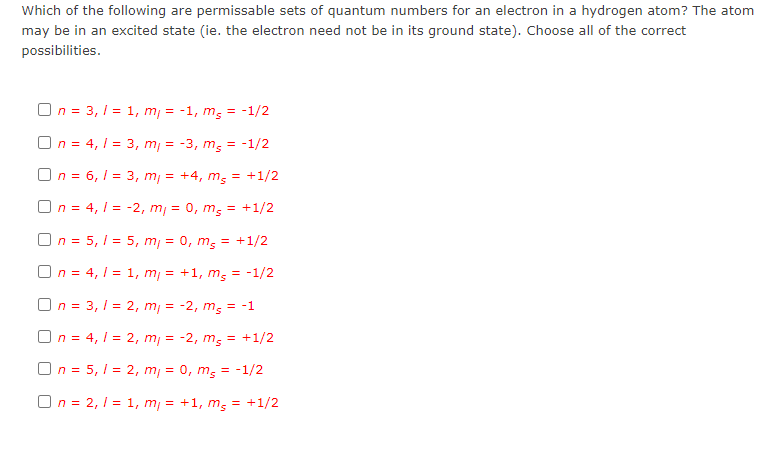Which of the following are permissable sets of quantum numbers for an electron in a hydrogen atom? The atom may be in an excited state (ie. the electron need not be in its ground state). Choose all of the correct possibilities. On = 3, 1 = 1, m¡ = -1, m, = -1/2 On = 4, 1 = 3, m¡ = -3, m; = -1/2 On = 6, I = 3, m, = +4, m; = +1/2 %3D On = 4, 1 = -2, m¡ = 0, m; = +1/2 %3D On = 5, 1 = 5, m¡ = 0, m, = +1/2 On = 4, 1 = 1, m¡ = +1, m; = -1/2 %3D On = 3, 1 = 2, m = -2, m, = -1 On = 4, 1 = 2, m¡ = -2, m; = +1/2 On = 5, 1 = 2, m¡ = 0, m; = -1/2 On = 2, 1 = 1, m¡ = +1, m; = +1/2
Which of the following are permissable sets of quantum numbers for an electron in a hydrogen atom? The atom may be in an excited state (ie. the electron need not be in its ground state). Choose all of the correct possibilities. On = 3, 1 = 1, m¡ = -1, m, = -1/2 On = 4, 1 = 3, m¡ = -3, m; = -1/2 On = 6, I = 3, m, = +4, m; = +1/2 %3D On = 4, 1 = -2, m¡ = 0, m; = +1/2 %3D On = 5, 1 = 5, m¡ = 0, m, = +1/2 On = 4, 1 = 1, m¡ = +1, m; = -1/2 %3D On = 3, 1 = 2, m = -2, m, = -1 On = 4, 1 = 2, m¡ = -2, m; = +1/2 On = 5, 1 = 2, m¡ = 0, m; = -1/2 On = 2, 1 = 1, m¡ = +1, m; = +1/2
Chemistry
10th Edition
ISBN:9781305957404
Author:Steven S. Zumdahl, Susan A. Zumdahl, Donald J. DeCoste
Publisher:Steven S. Zumdahl, Susan A. Zumdahl, Donald J. DeCoste
Chapter7: Atomic Structure And Periodicity
Section: Chapter Questions
Problem 12ALQ: There are an infinite number of allowed electronic transitions in the hydrogen atom. Why dont we see...
Related questions
Concept explainers
Atomic Structure
The basic structure of an atom is defined as the component-level of atomic structure of an atom. Precisely speaking an atom consists of three major subatomic particles which are protons, neutrons, and electrons. Many theories have been stated for explaining the structure of an atom.
Shape of the D Orbital
Shapes of orbitals are an approximate representation of boundaries in space for finding electrons occupied in that respective orbital. D orbitals are known to have a clover leaf shape or dumbbell inside where electrons can be found.
Question

Transcribed Image Text:Which of the following are permissable sets of quantum numbers for an electron in a hydrogen atom? The atom
may be in an excited state (ie. the electron need not be in its ground state). Choose all of the correct
possibilities.
On = 3, 1 = 1, m = -1, m, =
= -1/2
On = 4, 1 = 3, m, = -3, m; = -1/2
On = 6, I = 3, m, = +4, m; = +1/2
On = 4, 1 = -2, m, = 0, m,
= +1/2
On = 5, I = 5, m, = 0, m; = +1/2
On = 4, 1 = 1, m, = +1, m; = -1/2
On = 3, 1 = 2, m, = -2, m; = -1
On = 4, 1 = 2, m, = -2, m; = +1/2
On = 5, I = 2, m = 0, m; = -1/2
On = 2, 1 = 1, m = +1, m; = +1/2
Expert Solution
This question has been solved!
Explore an expertly crafted, step-by-step solution for a thorough understanding of key concepts.
Step by step
Solved in 2 steps with 1 images

Knowledge Booster
Learn more about
Need a deep-dive on the concept behind this application? Look no further. Learn more about this topic, chemistry and related others by exploring similar questions and additional content below.Recommended textbooks for you

Chemistry
Chemistry
ISBN:
9781305957404
Author:
Steven S. Zumdahl, Susan A. Zumdahl, Donald J. DeCoste
Publisher:
Cengage Learning

Principles of Modern Chemistry
Chemistry
ISBN:
9781305079113
Author:
David W. Oxtoby, H. Pat Gillis, Laurie J. Butler
Publisher:
Cengage Learning

Chemistry for Engineering Students
Chemistry
ISBN:
9781337398909
Author:
Lawrence S. Brown, Tom Holme
Publisher:
Cengage Learning

Chemistry
Chemistry
ISBN:
9781305957404
Author:
Steven S. Zumdahl, Susan A. Zumdahl, Donald J. DeCoste
Publisher:
Cengage Learning

Principles of Modern Chemistry
Chemistry
ISBN:
9781305079113
Author:
David W. Oxtoby, H. Pat Gillis, Laurie J. Butler
Publisher:
Cengage Learning

Chemistry for Engineering Students
Chemistry
ISBN:
9781337398909
Author:
Lawrence S. Brown, Tom Holme
Publisher:
Cengage Learning

Chemistry: An Atoms First Approach
Chemistry
ISBN:
9781305079243
Author:
Steven S. Zumdahl, Susan A. Zumdahl
Publisher:
Cengage Learning


Physical Chemistry
Chemistry
ISBN:
9781133958437
Author:
Ball, David W. (david Warren), BAER, Tomas
Publisher:
Wadsworth Cengage Learning,